
These organisms are often detected by ear sampling and culture and sensitivity. Secondary factors include opportunistic bacteria and yeast overgrowth, most commonly by Malassezia pachydermatis. Less common but documented parasitic primary causes of otitis externa include Demodex species, Notoedres cati, Sarcoptes scabiei, Cheyletiella species, Eutrombicula alfreddugesi, and Neotrombicula autumnalis. Specific primary causes detectable by ear sampling include parasites such as Otodectes cynotis (ear mite of dogs and cats), Psoroptes cuniculi (ear mite of rabbits and goats), and Otobius megnini (spinose ear tick of dogs).

Primary factors are those that cause infections in healthy ears. 3,4 Ear cytology is also an invaluable tool in monitoring therapy, with rechecks performed weekly or biweekly as treatment progresses until there is no evidence of infection on cytology samples. This, in turn, helps guide the veterinarian’s choice of the most effective therapy or further tests, such as culture and sensitivity. A skilled veterinary nurse can enhance the veterinarian’s diagnosis by performing ear cytology and correctly identifying microorganisms by group. 3 With antimicrobial resistance on the rise, selective treatment options are critical in combating infectious organisms. 2 Ear cytology is a simple, quick, routine procedure that can be used to rule out or identify microbial otic infection in any animal that presents with these signs. When to Perform Ear CytologyĮvaluation of clinical signs related to otitis externa ( BOX 1 ) is one of the most common reasons animals present to the clinic. This article discusses the rationale for performing ear cytology and covers the step-by-step process of collecting, staining, and evaluating samples. Collecting, processing, and evaluating ear cytology samples are skills all credentialed veterinary technicians and nurses learn in credentialing programs.¹ Ear cytology is a simple tool to evaluate pruritic ears and is relatively inexpensive.


 0 kommentar(er)
0 kommentar(er)
